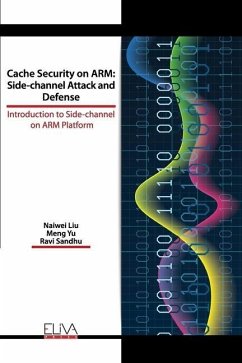Nicht lieferbar

Deep Learning to Detect Cyber Attacks
Versandkostenfrei!
Nicht lieferbar
"Deep Learning to Detect Cyber Attacks" is a comprehensive and cutting-edge book that explores the application of deep learning techniques in detecting and mitigating cyber attacks. Authored by experts in the field of cybersecurity and machine learning, this book serves as an invaluable resource for cybersecurity professionals, researchers, and students interested in leveraging the power of deep learning to enhance cyber defense systems. In this book, the authors delve into the ever-evolving landscape of cyber threats and the challenges faced by traditional intrusion detection systems. They in...
"Deep Learning to Detect Cyber Attacks" is a comprehensive and cutting-edge book that explores the application of deep learning techniques in detecting and mitigating cyber attacks. Authored by experts in the field of cybersecurity and machine learning, this book serves as an invaluable resource for cybersecurity professionals, researchers, and students interested in leveraging the power of deep learning to enhance cyber defense systems. In this book, the authors delve into the ever-evolving landscape of cyber threats and the challenges faced by traditional intrusion detection systems. They introduce deep learning, a subset of machine learning that utilizes artificial neural networks with multiple layers, as a powerful approach to detecting and mitigating cyber attacks with improved accuracy and efficiency. Key topics covered in this book include:Introduction to deep learning: The authors provide a comprehensive overview of deep learning, its architecture, and its applications in various domains. Readers gain a fundamental understanding of neural networks, convolutional neural networks (CNNs), recurrent neural networks (RNNs), and other deep learning models. Cyber attack detection: The book explores the intricacies of cyber attacks and the methods employed by threat actors to compromise systems. It discusses different types of attacks, including malware, phishing, ransomware, and distributed denial-of-service (DDoS) attacks, and demonstrates how deep learning techniques can be utilized to detect and mitigate these threats. Feature extraction and data representation: The authors delve into the process of feature extraction and data representation in the context of cyber attack detection. They explore methods such as dimensionality reduction, feature selection, and data preprocessing, highlighting the importance of transforming raw data into meaningful representations for effective deep learning models. Deep learning architectures for cyber attack detection: The book covers various deep learning architectures and algorithms suitable for cyber attack detection. It examines the application of CNNs, RNNs, generative adversarial networks (GANs), and deep reinforcement learning, showcasing how these models can be trained to identify patterns and anomalies indicative of cyber attacks. Adversarial attacks and defense: The authors address the growing concern of adversarial attacks, where cyber attackers attempt to manipulate or deceive deep learning models. They discuss techniques for adversarial training and model robustness, ensuring that deep learning-based cyber defense systems are resilient against sophisticated attacks. Real-world applications and case studies: The book includes practical examples and case studies that demonstrate the application of deep learning in detecting cyber attacks across different sectors. Examples include network intrusion detection, email filtering, malware detection, and anomaly detection, providing insights into real-world implementation challenges and considerations. Throughout the book, the authors provide practical guidance, algorithmic explanations, and code snippets to facilitate the understanding and implementation of deep learning techniques for cyber attack detection. By harnessing the power of deep learning, "Deep Learning to Detect Cyber Attacks" equips readers with the knowledge and tools necessary to develop advanced and efficient cyber defense systems that can effectively combat the constantly evolving threat landscape.






